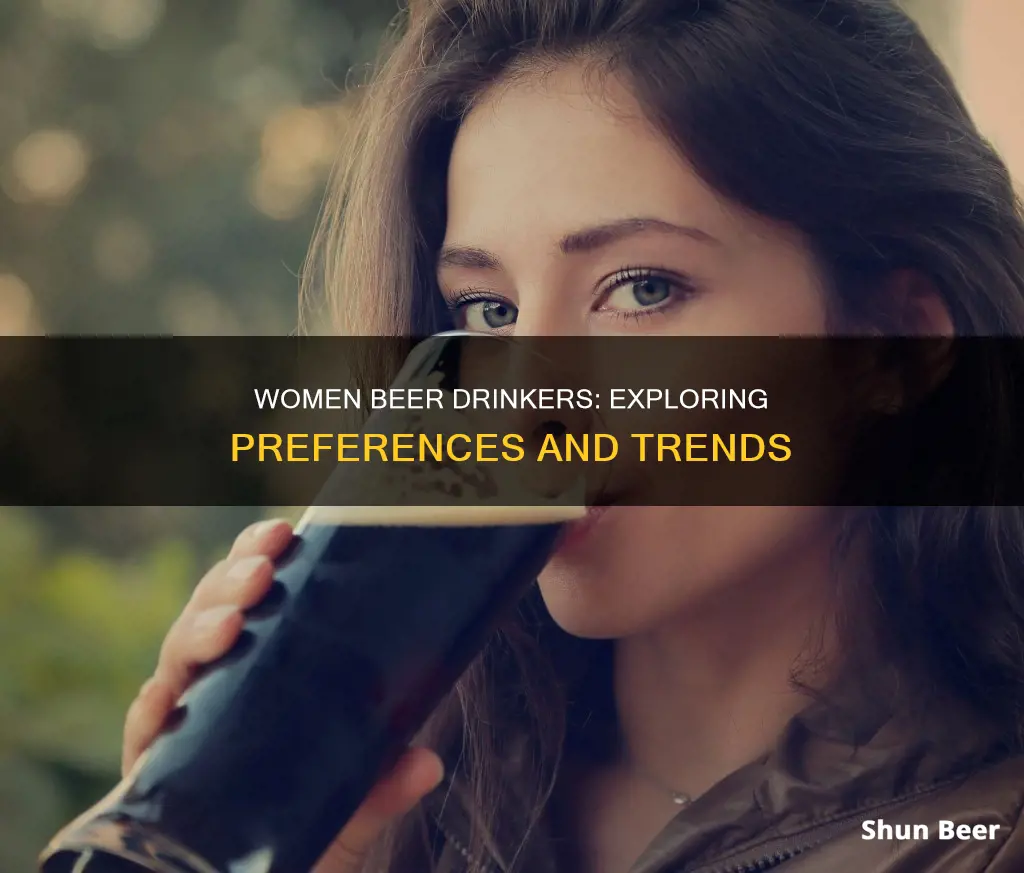
Despite the fact that women have historically been integral to the production and consumption of beer, the drink has become synonymous with masculinity in modern times. This shift can be attributed to various factors, including the transformation of beer from sustenance to leisure, the emergence of diet culture, and the anchoring of beer as an element of 'lad' culture, particularly in university settings. While some women continue to face stereotypes and judgment for drinking beer, others are challenging these outdated gender norms and fighting for better representation in the beer industry.
| Characteristics | Values |
|---|---|
| Percentage of women who drink beer at least once a week | 17% |
| Percentage of men who drink beer at least once a week | 53% |
| Reasons women avoid drinking beer | Stereotypes, fear of bloating, laddish marketing campaigns |
| Beer consumption in ancient Mesopotamia | Brewed most typically by women |
What You'll Learn

Women's historical role in beer production
Women have played a significant role in beer production throughout history, with evidence of their involvement dating back to ancient times. From the earliest days of brewing around 7000 BCE until the industrialization of the process, women were the primary brewers across all inhabited continents. Here is a detailed look at the historical role of women in beer production:
Ancient Times to Middle Ages
In ancient societies, such as the Sumerians, Babylonians, and Egyptians, brewing was often associated with female deities and goddesses of fertility and protection. For example, the Sumerian goddess Ninkasi was considered the goddess of beer. Brewing was seen as a domestic task, and women were responsible for producing beer for religious ceremonies and practical purposes. Beer was a calorie-rich beverage that was consumed more frequently than water. In some cultures, such as the Vikings, only women were allowed to brew ale.
Renaissance to Early Modern Period
During the Renaissance and the Reformation in the early 16th century, stricter gender norms began to emerge, and women's roles in brewing started to change. With the rise of fundamentalist religious movements, women were condemned for witchcraft, and male brewers took advantage of this climate to reduce competition by accusing female brewers of being witches. Over time, it became dangerous for women to continue brewing due to the risk of being misidentified as witches, which could lead to prosecution or even death. As a result, women were gradually pushed out of the brewing industry.
Industrialization to Modern Times
With industrialization, the commercialization of brewing further marginalized women's participation. From the 18th century onwards, women took on roles such as barmaids, pub operators, bottlers, or secretaries in breweries. In less industrialized areas, women continued to produce homebrews and traditional alcoholic beverages. It wasn't until the mid-20th century that women started working as chemists in brewing establishments and began re-entering the field as brewers in the 1960s and 1970s.
Today, women are still underrepresented in the beer industry, but they are slowly making inroads. Organizations like the Pink Boots Society, founded by female brewmaster Teri Fahrendorf, aim to empower women in the beer industry. Women like Carol Stoudt of Stoudt's Brewing Company are leading the way as one of the first female brewmasters in the United States.
Beer and Belly Bloat: Is Your Beverage to Blame?
You may want to see also

Beer advertising and gender stereotypes
The use of gender stereotypes in beer advertising can be off-putting to women, who may feel reduced to a single category of membership. For example, the colour pink, glitter, and floral images are often used in beer advertising aimed at women, perpetuating a narrow definition of femininity. Additionally, beer advertising for women often draws on insecurities and anxieties about body image, presenting the drinks as a solution to concerns about calorie content. This type of marketing can reinforce the idea that women should be concerned with controlling their calories, confidence, and emotions.
The impact of gender-specific beer advertising on women's drinking practices is not well understood, with limited research in this area. However, qualitative research suggests that women do pay attention to whether drinks are marketed as 'feminine' and choose their drinks accordingly. Women also appear to pay more attention to the aesthetics of drinks than men, sometimes viewing alcoholic beverages as fashion accessories.
The use of gender stereotypes in beer advertising is not universal, and there are examples of campaigns that challenge traditional gender roles. For instance, The Campaign for Real Ale (CAMRA) in the UK has introduced a code of conduct that bans sexist marketing, aiming to increase beer sales among women. Similarly, BrewDog has used ironic gender stereotypes to raise awareness of the gender pay gap through its "Pink beer for Girls" IPA.
While the use of gender stereotypes in beer advertising can be off-putting to some consumers, it is important to recognise that not all individuals conform to gender stereotypes in their drink choices. There are women who enjoy drinking beer and men who prefer sweeter drinks. Ultimately, the decision to consume a particular beverage is influenced by a variety of factors, including personal taste, cultural norms, and marketing messages.
Do Cyclists Enjoy Beer? Exploring Beverage Preferences
You may want to see also

Beer drinking in social settings
The notion that beer is exclusively for men is perpetuated by advertising and media that portray beer drinking as a masculine activity. This is further reinforced by the design of beer packaging, which often features bold, arrogant prints and masculine motifs. Additionally, beer drinking is closely linked to leisure activities that are typically associated with men, such as watching football or socialising in pubs or bars.
In social settings, such as pubs or bars, women who order beer may be subjected to judgement or comments from both bartenders and peers. Bartenders may assume that a woman would prefer a 'feminine' drink and may even place the wrong drink in front of her based on gendered stereotypes. This reinforces the idea that beer is not a drink for women and contributes to a woman's fear of being judged for her drink choice.
To make beer more appealing to women, the beer industry has sometimes fallen into the trap of simply adding feminine colours or designs to their products, such as pink pumps or frills on lager bottles. However, this approach fails to address the underlying issue of gender stereotypes and can even reinforce them. Instead, women want the beer industry to reconsider how beer is presented and positioned to them, without creating a separate category of 'beer for women'.
Despite the stereotypes and judgements, there is a growing number of women who are embracing beer drinking and challenging the outdated notion that beer is exclusively for men. This shift is reflected in the increasing number of female brewers, female-owned breweries, and women in the craft beer scene. By sharing their stories and experiences, these women are helping to break down gender barriers and redefine beer drinking as a universal activity that anyone can enjoy.
Cats and Beer: A Curious Combination
You may want to see also

Gendered associations with wine and spirits
The association of certain types of alcohol with specific genders is a well-documented phenomenon. While gender is not the only lens through which alcohol preferences are viewed, it is perhaps the most prominent one.
Beer
Beer is often associated with men and considered a "man's drink". This perception is so ingrained that women who drink beer often face stereotypes and judgement. However, this gendering of beer is not inherent but rather a result of societal norms and marketing. In reality, a significant number of women enjoy drinking beer, and the notion of beer as a solely male beverage is a recent development.
Historically, women played a central role in brewing and distilling, with evidence suggesting that women were the primary brewers in ancient societies across the globe. The association of beer with masculinity is believed to have solidified during the Industrial Revolution, when brewing and distilling shifted from a predominantly female domestic activity to a male-dominated commercial industry.
Wine
Wine, like beer, has undergone a gendered transformation over time. While it was once considered a masculine drink, it is now often associated with femininity. This shift can be attributed in part to popular media and entertainment, which tend to reinforce gender stereotypes and influence societal perceptions.
The language used to describe wine also contributes to its gendering. Terms like "powerful", "tannic", "bold", and "strong" are typically associated with masculinity, while adjectives like "elegant", "silky", "fruity", and "sweet" convey femininity. These gendered descriptors can influence consumer behaviour, with wines described as feminine perceived as having a more limited ageing potential and being better suited for quicker consumption.
Spirits
When it comes to spirits, gendered associations vary depending on the specific drink. Vodka, for example, is often considered a feminine drink, while darker or harder alcohols like whiskey and rum are typically associated with males. These gendered perceptions are reflected in media portrayals, such as the characterisation of Jack Torrance in "The Shining" ordering a masculine whiskey to reaffirm his masculinity. On the other hand, the character Richard Webber in "Grey's Anatomy" is revealed as an alcoholic through his consumption of vodka, a spirit that carries feminine connotations.
The gendering of spirits can also be influenced by factors like class and status. For instance, a gin and tonic may be associated with a well-groomed, classy man, challenging traditional gender stereotypes.
While gender is a significant factor in shaping alcohol preferences and consumption patterns, it is essential to recognise that these associations are socially constructed and subject to change over time.
Mountain Men and Their Beer Drinking Habits
You may want to see also

Calories and bloating concerns
Calories and bloating are two major concerns for women who drink beer. Beer is calorie-dense, with an average of 170 calories in an ordinary lager, and up to 580 calories in a vintage sweet cider. Booze is, in fact, only second to fat when it comes to calorie content. These calories can contribute to long-term obesity and health issues.
The high calorie content of beer is due to its alcohol content. Alcohol is processed by the liver, which can only break down about one unit of alcohol per hour. When alcohol is consumed faster than it can be broken down, it builds up in the bloodstream, leading to damaging effects on the body's cells.
Beer is also notorious for causing bloating, which can cause several days of discomfort and digestive issues. This is because alcohol is an inflammatory substance that causes swelling and irritates the digestive system, leading to increased acid production in the stomach. Mixers that are often added to alcoholic drinks tend to be full of sugar and carbon dioxide, further exacerbating the bloating effect.
Additionally, alcohol consumption leads to dehydration, causing the body to retain water and resulting in swelling. Carbonated alcoholic drinks, such as beer, contain carbon dioxide, leading to the consumption of excess gas and contributing to bloating. These drinks are also often high in carbohydrates and sugar, which further contribute to bloating.
To prevent alcohol-related bloating, it is recommended to avoid carbonated drinks, quit smoking, and stay hydrated by drinking water before, during, and after consuming alcohol.
Root Beer's Alcoholic Mystery: Beverage's Surprising History
You may want to see also
Frequently asked questions
There is no biological reason for women to dislike beer, but societal expectations and stereotypes play a role in their drinking choices. Women are often expected to drink wine, cocktails, or other sweet alcoholic drinks, while beer is considered a "man's drink".
Women who drink beer are often branded as "pick-me girls" or seen as trying to be "one of the boys". They may also be perceived as less feminine, "bold", or "confident".
According to a report by Dea Latis, women may be put off by "laddish" marketing campaigns and fear of bloating. They may also worry about being judged for drinking beer, which is still seen as a "man's drink".
Beer advertising often reinforces gender stereotypes by targeting men and perpetuating the idea that beer is a masculine drink. Efforts to attract women drinkers have included using female-coded language and imagery, such as suggesting that beer is "elegant" or "sophisticated".
Women have historically been integral to the production and consumption of beer. In ancient Mesopotamia, beer was typically brewed by women, and the goddess Ninkasi was associated with brewing. During the Middle Ages, women played a key role in developing beer recipes and running taverns or alehouses. However, from the Early Modern period onwards, women's participation in beer-drinking spaces declined due to the exclusionary nature of "lad" culture and gendered expectations about women's roles.







